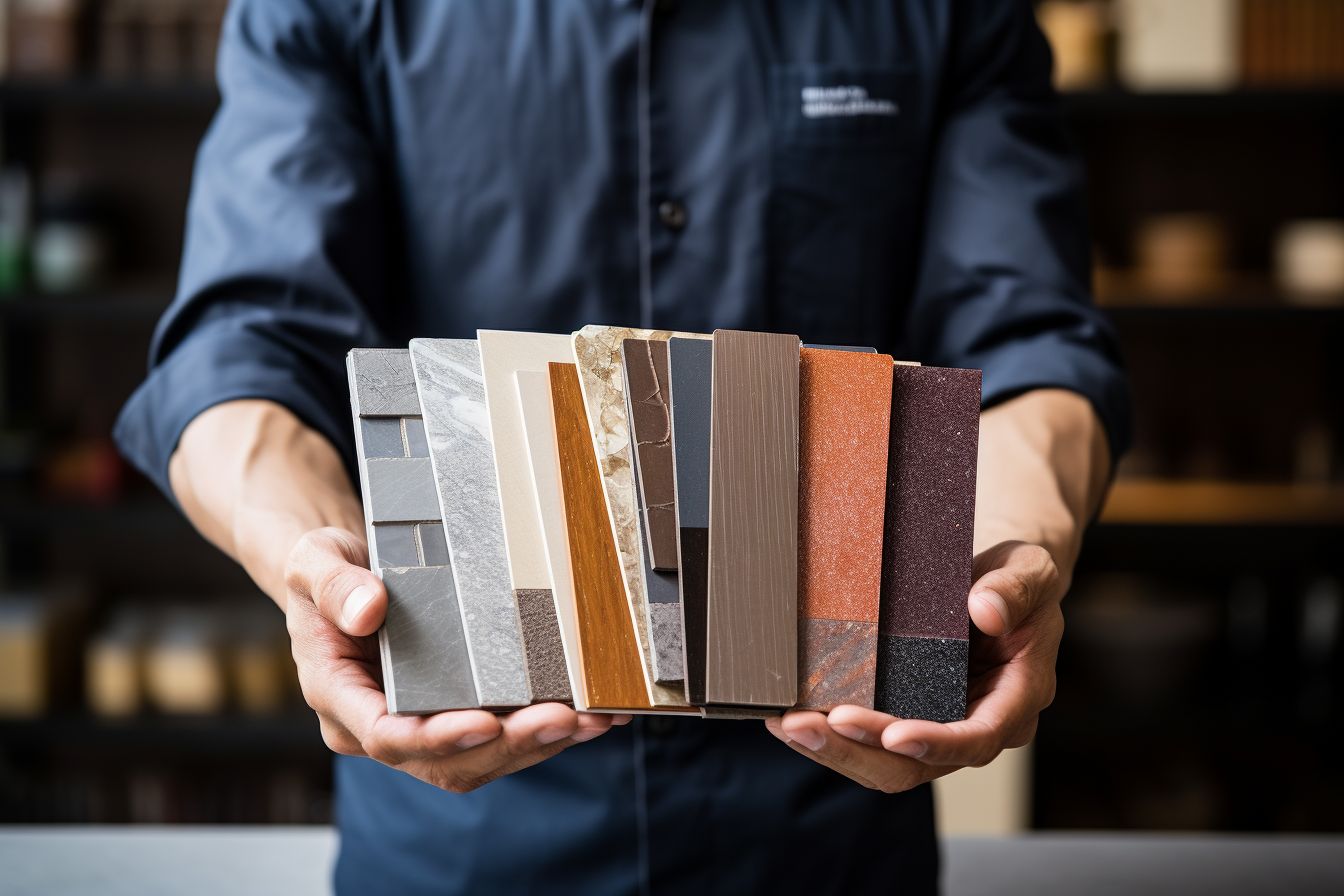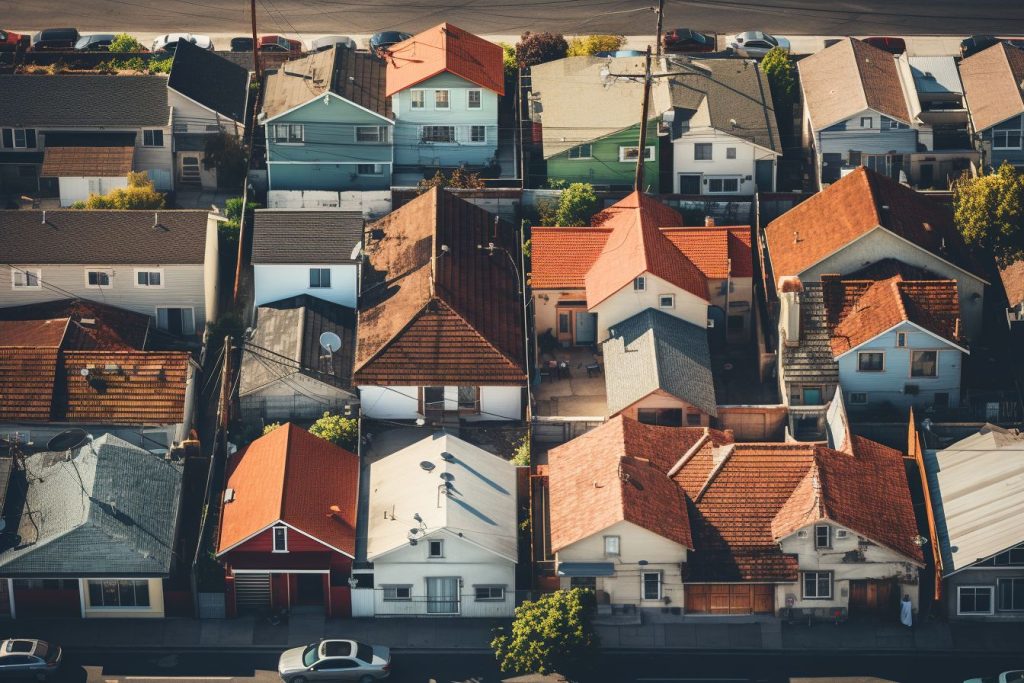Choosing the right shape for your roof can be a daunting task. Did you know that the shape of your roof significantly impacts your home’s curb appeal, cost, and wind resistance? This comprehensive guide will walk you through common and lesser-known roof shapes, their characteristics and benefits to help simplify your choice.
Stay with us as we unlock the perfect match for your home!
Key Takeaways
- Gable roofs are a practical and versatile option for homeowners, providing ample attic space and excellent ventilation.
- Hip roofs offer a continuous slope that enhances structural integrity and is especially beneficial in areas prone to high winds or heavy snowfall.
- Mansard roofs combine hip and gambrel styles, creating a distinctive design offering additional living or storage space within the structure.
Most Common Roof Shapes

The most common roof shapes include gable, hip, mansard, gambrel, flat, and low slope.
Gable
A gable roof is an incredibly popular choice among U.S. homeowners due to its distinctive shape, with two sloping sides that meet at a ridge. This junction creates triangular end walls, known as gables.
Various materials, including siding and stone, can be used to construct these end walls. Many roofing materials, like asphalt shingles, cedar shakes, or slate tiles, are suitable for gable roofs, giving them versatility in style and appearance.
Known for providing ample attic space and excellent ventilation, a gable roof is a practical yet aesthetically pleasing choice for any home structure.
Hip
A hip roof stands out as one of the most common roof shapes. This design offers all four sides sloping downwards from the peak, creating an elegant and functional structure. A hip roof has no flat or vertical end, unlike other designs, such as the gable roof.
The construction of hip roofs involves framing with a ridge board at the topmost point where different faces of the roof converge. Not only does this provide aesthetic appeal, but it also enhances structural integrity.
The continuous slope offered by this roofing style is especially beneficial in areas prone to high winds or heavy snowfall.
Mansard
Originating from French architecture, the Mansard roof, or a French or curb roof, offers an intriguing mix of design elements. Resembling a hip roof but with the addition of a steeper lower slope on all four sides, its unique shape commands attention.
This style is so iconic that even internationally renowned buildings such as the Louvre Museum in Paris proudly showcase it. The combination of hip and gambrel styles results in this distinctive design, leading to additional living or storage space within the structure itself.
Despite its elaborate structure, this common roof shape remains popular for those seeking functionality and aesthetic appeal in their building design.
Gambrel
Popular in Cape Cod-style homes, the Gambrel roof showcases two distinctive slopes on each side. The upper slope presents a shallower angle compared to the lower one, creating an intriguing visual contrast.
This type of symmetrical design also features in Mansard roofs – a more French take on this Dutch-inspired gambrel style. Traditionally linked with barn structures and classic Dutch architecture, it’s not just unique but highly practical, offering ample interior space due to its steep, sloping angles.
Flat
Often considered completely level, flat roofs still require a slight slope for sufficient water drainage. They are usually seen in homes with limited flat surface area combined with other roof designs, such as gable or hip roofs.
Roofing materials commonly used for flat structures include EPDM rubber, TPO, PVC roofing membranes and tar. Despite being referred to as shallow sloped roofs, each type boasts its unique advantages.
Comparatively flat surfaces allow more functional use of space through rooftop gardens or solar panel installation. Therefore, this could make them an appealing choice depending on the architectural requirements of your building project.
Low Slope
Low-slope roofs are often preferred for their simplicity in design and construction. The key attribute to these roofs is a pitch that’s generally 4 in 12 or less, making them easier to construct due to the need for fewer roofing materials.
Despite the low slope, all roofs should have some degree of gradient for effective water drainage.
Shed homes typically incorporate steeper slopes than what is found on many other low-slope designs. This aids in efficient water runoff, which helps prevent structural damage over time.
Though they might resemble flat roofs from afar, shallow slope roofs have a slight angle that allows rainwater to flow off safely into gutters and downspouts. These attributes make it integral within the roofing industry, as it balances both practicality and aesthetic appeal.
Lesser Known Roof Shapes

– The A-Frame, Saltbox, Bonnet, Monitor, Butterfly or V-Roof, Arched, Domed, and Sawtooth are lesser-known roof shapes that offer unique design options for homeowners.
A-Frame
The A-Frame roof takes its name from its distinctive shape, offering a unique design element to any structure. It resembles the alphabet ‘ A ‘ with symmetrical, angled sides that come together at the peak.
This design is commonly implemented in triangular-shaped homes structured with a series of rafters or trusses. It’s not unusual to spot A-frame roofs on barns, farmhouses and log cabins due to their traditional aesthetic appeal.
Many Dutch Colonial or Georgian-style homes also feature this popular roof shape for an added architectural interest.
Saltbox
Saltbox houses are a unique and charming example of Colonial architecture, particularly in New England. Named after the design of kitchen salt storage boxes from the Colonial era, saltbox roofs have a distinct shape.
These roofs are long and rectangular, with the ridge running along the long end. One side of the roof is flat with a slight slope, while the other has a more “lean-to” structure.
This asymmetrical design adds character to traditional houses and is often seen as an architectural highlight in historic neighbourhoods.
Bonnet
Bonnet roofs are a lesser-known roof shape characterized by double slopes. The lower slope is set at a less steep angle than the upper slope, giving it a unique aesthetic appeal. Sometimes called kicked-eaves roofs, bonnet roofs add style to a house and offer shade and protection from the elements.
It’s important to note that constructing a bonnet roof can be more expensive than other roof types due to its complex design.
In conclusion, choosing a bonnet roof might be worth considering if you’re looking for a roof style that stands out and provides both visual appeal and functionality. Remember that this option may come with an additional cost, but the unique look and added shade make it an attractive choice for many homeowners.
Monitor
A monitor roof is a unique and lesser-known shape that adds an extra level to a building. This raised section runs parallel to the primary roof and creates a ‘second’ roof.
It is often equipped with windows or skylights, allowing natural light to enter the space below. Not only does this provide ample sunlight, but it also allows for additional ventilation and airflow by installing vents or louvres.
The design of a monitor roof can maximize usable space within a building, making it perfect for storage or creating extra work areas. When it comes to construction, monitor roofs can be made using various materials such as asphalt shingles, metal, or even glass.
Butterfly or V-Roof
The Butterfly or V-Roof is a lesser-known roof shape characterized by its unique V-shaped design with two raised wings that meet in the middle. Also known as a split gable roof, this architectural style offers an attractive and distinctive look to any building or structure.
The roof consists of two slopes that slope downward from the centre, resembling a butterfly’s wings. Commonly used in high-rise buildings and considered a design feature in modern architecture, the Butterfly or V-Roof adds an element of sophistication and elegance to any roofing system.
Arched
Arched roofs are known for their distinctive curved design, often seen in Gothic architecture and cathedral roofs. These roofs can range from low slopes to rounded peaks, giving them a unique look that stands out from other roof shapes.
Arched roofs can take on different forms, such as barrel vaults or vaulted designs, adding even more visual interest to the structure. Additionally, dormer windows with arched tops are another feature found in buildings with this type of roof shape.
Overall, arched roofs offer a striking aesthetic and can enhance the beauty of any building or structure they adorn.
Domed
Domes are a lesser-known roof shape that is considered crucial in architecture. These curved buildings have no corners or straight lines, giving them a unique and eye-catching appearance.
Domes evolved from the arch and are often used as ceilings or roofs. The semi-circle shape of a domed roof maintains the same structure all the way around, creating a sense of balance and harmony.
One famous example is the Cathedral of Santa Maria del Fiore, which boasts the largest masonry dome in the world. It took over 140 years to complete this impressive architectural feat.
Sawtooth
A sawtooth roof is a unique design with a series of ridges with dual pitches on either side. This distinctive shape allows abundant natural light to enter the building through glass panels.
The sawtooth roof optimizes space and provides an unobstructed view for those living inside. Due to its layout, this type of roof is often found in residential or non-industrial buildings.
Additionally, the design of a sawtooth roof offers excellent resistance against strong winds, making it highly durable and less likely to be damaged during storms or inclement weather.
A Comprehensive Guide to Roofing Materials

Roofing materials play a crucial role in determining the durability and performance of your roof. Here are some popular roofing materials to consider:
- Metal roof: Provides excellent durability and is resistant to fire, wind, and hail damage.
- Asphalt shingle roof: A cost-effective option in various styles and colours.
- Slate roof: Known for its timeless beauty and longevity, it can be expensive.
- Wood roofing: Offers a natural aesthetic appeal but requires regular maintenance.
- Tile roof: Durable and available in different styles, such as clay or concrete tiles.
- Rubber roof: Ideal for flat or low-slope roofs due to its flexibility and resistance to leaks.
- Green roof: A sustainable option that uses vegetation to reduce energy costs and stormwater runoff.
- Solar roof: Combines solar panels with traditional roofing materials to generate electricity.
Factors to Consider When Choosing a Roof Shape

Consider the source of the water, contaminants to remove, and filter capacity for a well-informed decision. Read more to make an informed choice about your roof shape.
Source of the water
The water source is an important factor to consider when choosing a roof shape. Different shapes may be more suitable depending on where the water comes from. For example, if you rely on rainwater collection for your water supply, a flat or low slope roof shape might not be ideal as it can cause water to pool and potentially lead to leaks.
On the other hand, a gable or hip roof shape with sloping sides can help direct rainwater towards gutters and prevent build-up. By considering the water source, you can choose a roof shape best suited for your needs while ensuring efficient water management.
Contaminants to remove
If not addressed, chemical contamination in roof-collected water supplies can pose potential health risks. When choosing a roof shape, it is important to consider the sources of external contaminants, such as pollutants from nearby industries or agricultural activities.
By selecting a design that minimizes contact with these harmful substances, you can help ensure the safety and quality of your collected water. Assessing the presence of chemical contaminants and taking measures to eliminate them is crucial for maintaining a reliable water supply for your household needs.
Filter capacity and replacement frequency
Consideration of filter capacity and replacement frequency is crucial when choosing a roof shape for optimal filtration. The filter capacity determines how much water the roof can collect, while the replacement frequency refers to how often filters need to be replaced.
These factors are important as they impact the efficiency of your filtration system and ensure that contaminants are effectively removed from the collected water. Selecting a roof shape that aligns with your specific filtration needs and maintenance requirements, considering both filter capacity and replacement frequency, is essential.
How to Choose a Roof Shape
To choose a roof shape, first determine the source and quality of your water, then identify the contaminants you need to remove. Next, consider filter capacity, replacement frequency, and the climate and type of structure you are dealing with.
Determine the source and quality of your water.
To choose the right roof shape, you need to determine the source and quality of your water. This is important because different roofing materials have varying abilities to drain water effectively.
Knowing where your water comes from and its quality will help you select a roof shape to prevent water damage and ensure proper drainage. Additionally, understanding the contaminants that may be present in your water will allow you to choose a roofing material with the appropriate filter capacity to remove these contaminants.
Finally, considering the frequency of filters needing replacement is crucial for maintaining clean and safe water. So before deciding on a roof shape, know where your water comes from and what needs to be removed to keep it pure.
Identify the contaminants you need to remove
To ensure clean and safe water, it is crucial to identify the contaminants that need to be removed. These include volatile organic compounds (VOCs), semi-volatile organic compounds (SVOCs), and small particulate matter.
These pollutants can negatively affect indoor air quality, leading to health issues. By identifying these contaminants, you can choose a roof shape that minimizes their presence and select appropriate roofing materials that effectively remove them from your water supply.
Additionally, implementing safe practices when dealing with these contaminants is essential to protect workers involved in roofing activities.
Consider filter capacity and replacement frequency.
When choosing a roof shape, it is important to consider the filter capacity and replacement frequency. These factors play a crucial role in the performance and durability of the roof.
By understanding the filter capacity, you can effectively maintain the cleanliness and functionality of your roof. Regular replacement of filters ensures that your roof functions properly.
Choosing the right filter capacity and replacement frequency contributes to your roof system’s overall efficiency and effectiveness. So, make sure to take these considerations into account when selecting a roof shape for optimal maintenance and performance.
Consider the climate and type of structure that you are dealing with
The climate and type of structure you are dealing with should be carefully considered when choosing a roof shape. Different weather conditions can impact the performance and design of the roof, as well as influence your choice of shingles and roofing materials.
Additionally, the structural characteristics of your building will affect which roof shapes are suitable. By taking into account these factors, you can ensure that you select a roof shape that is not only aesthetically pleasing but also durable and efficient for your specific needs.
Conclusion

Choose the perfect roof shape for your home by considering climate, architectural style, and personal preferences. Consult with roofing professionals or architects to ensure durability, energy efficiency, and aesthetics are taken into account.
Make a decision that will enhance your home’s curb appeal and functionality.
FAQs
1. What factors should I consider when choosing a roof shape?
When choosing a roof shape, you should consider factors such as the climate in your area, the architectural style of your home, and any local building regulations.
2. What are the different types of roof shapes available?
There are several roof shapes, including gable, hip, flat, shed, and mansard roofs.
3. Which roof shape is best for high-wind areas?
A hip roof is often recommended in high-wind areas as it offers more resistance to strong winds than other roof shapes.
4. Can I change the shape of my existing roof?
Changing the shape of an existing roof can be complex and require major structural modifications. It’s best to consult with a professional architect or contractor before attempting any changes.
5. How does the choice of roof shape affect energy efficiency?
The choice of roof shape can impact energy efficiency by affecting factors such as sunlight exposure and air circulation in your home. For example, certain shapes like gable or hipped roofs may provide better ventilation and natural light than flat roofs.

